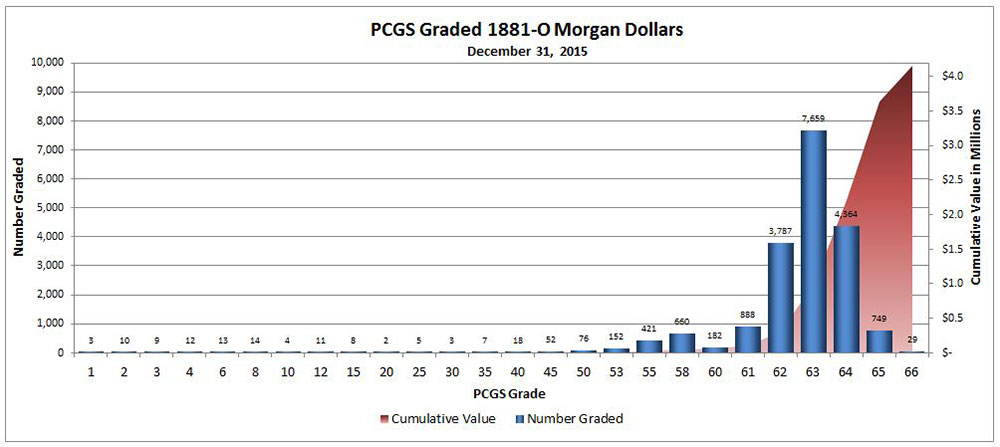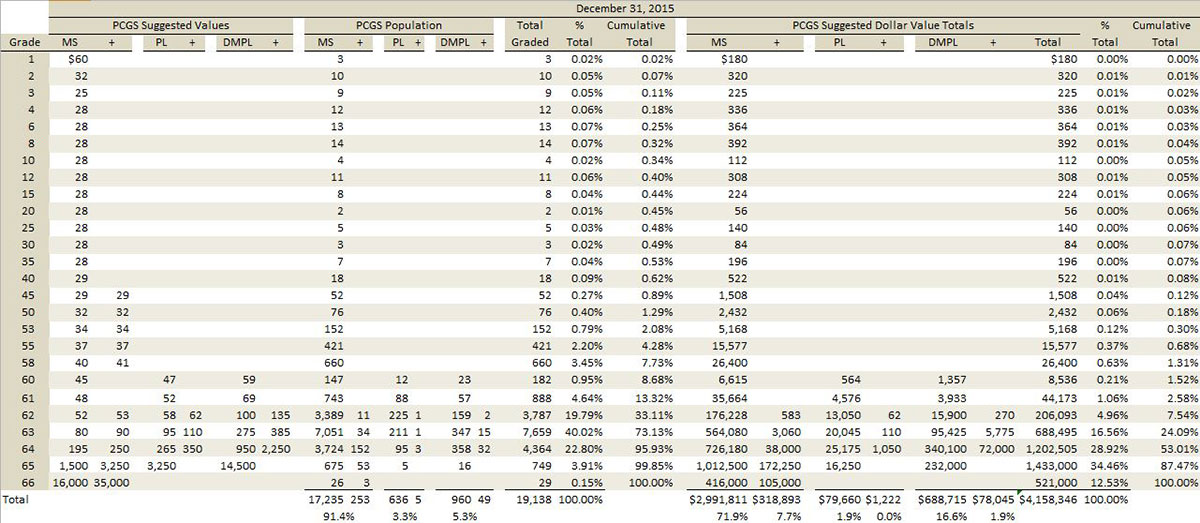
Statistics
Sources
Search
Contact
Home
There is much to be learned by following the macro numbers on coin grading, but one must be careful not to place too much emphasis on what you see. Many factors influence the grading of coins, not the least of which is grading costs.
Statistically Speaking
The High End
Finding Coins
While we focus our analysis on PCGS graded coins, we believe it is save to assume that very similar ratios would exist for other grading services.
The spreadsheet below was taken from statistics available on the PCGS web site regarding graded coins and approximate values.
Given the value derived from the combination of rarity and condition, the Mint State, Proof-Like, and Deep Mirror Proof-Like will always command a premium.
For us there are some surprises in the data. The relatively low quantities of PL and DMPL items should have been obvious because they tend to be lower for all issues. But the relative gap between MS and the other states probably serves to confirm the quality control issues mentioned in the History section of the web site.
Unlike the MS issue, the PL coins peak at grade 62. DMPL coins peak at grades 63 and 64. Prices for these coins rise quickly above these thresholds.
We will update these statistics periodically, but directionally they are unlikely to change much. We encourage all collectors to join PCGS and to participate in as many functions as possible.
The statistics furnished below are courtesy of PCGS and reprinted here with their permission. To see more go to PCGS.com.
Trending
Over the past year two things have happened with the 1881-O, and perhaps the coin markets in general. Grade by grade, most 1881-O coins below mint state 62 declined ever so little in value, but they did decline.
But the total value of PCGS graded 1881-O coins rose from $3.9 million to $4.15 million. Obviously the change in total value came from the combination of improvement in value of highly graded coins, but also from the addition of 1,025 coins to the total graded.
The trends in VAMs at PCGS is discussed in the VAM section of the web site. But at the highest level of discussion, nothing much happened.
From examining the data on the 1881-O coin it is very obvious that the bulk of the coins graded are from grade 60 through 66. Just 8% of the graded coins are below grade 60, although our grading process for this web site and analysis will skew those percentages when we really dig into the lower grades.
When you look at the cumulative value of the coins graded, from grade 60 up, they make up 98.5% of the total value. 77% of the total value is in just the top two grades.
Assuming your wallet can take it, if you are investing and not collecting (or a combination of the two) you would not want to buy anything lower than a grade 64 since the number of graded coins peaks at grade 63.
The Low End
It is likely that coins graded below grade 50 were done by Everyman and Low Ball collectors, together with novice collectors and collectors building grading sets. In the free market world PCGS and buyers might value many of these coins below the cost of bullion plus grading, so why bother.
We know that a good many of the coins in the lower grades were graded by us in building this set and when we participated in the Low Ball and Everyman competitions.
When you examine the grading area of this web site you will see that in some cases we hold a significant quantity of the items below AU grades. Of the 101 coins graded from 35 down to 01, we hold 58. So for comparison purposes we can demonstrate grading and grading differences clearly than any other collection.
In our opinion the low end of the grading scale deserves a great deal more consideration on rarity. On the high end of the grading scale there are few conditions that would keep a coin from being graded. On the high end you can send in just about any coin with mint luster and expect it to be graded unless the coin has been altered in some fashion.
On the low end of the scale there are a host of disqualifying condition issues that preclude most coins from even being graded. In the PCGS world these receive an N grade and the coins are delineated by disqualification reason. So the mere 2 coins graded as Poor 01 are a true rarity. One is included in our set and the other held by the current Low Ball Set leader.
Purchasers of coins from on line web sites and auctions are often criticized for overpaying for coins. But this perspective is truly in the eye of the purchaser. When gas peaked at more than $3.50 per gallon, the prospect of driving to get coins makes it impractical unless you know the coins you need will be there when you arrive, and you are buying in sufficient quantity to spread the cost over more than one coin.
The on line auctions are a true free market and we contend that without it prices would be very different. In the "good old days" inventories of coins often appeared to be much lower to any one collector bound by geography. With the Internet coin inventories appear from all over the globe, and buyers are free to pay whatever they feel is fair in open competition. On the supply side there are much larger inventories, and on the buying side there are many more purchasers.
A Note on Values
While we know PCGS takes great care in their analysis of coin markets, there are some items to consider. We take their data to be directionally correct, but not the final word.
First, the largest market for PCGS graded coins is probably eBay where there are in excess of 60,000 Morgan Dollars changing hands on a regular basis. This is a true open market, and we would challenge anyone to consistently find coins as low as many of the recommended PCGS values. So it is likely the total value of the coins out there is much higher.
Second, as lowball collecting has become more popular there is some pressure on the low end of all coins. PCGS gives coins below grade AU-50 very little value, but the rarity of these coins often makes them trade for much more, often five to ten times the stated value. As an example there are only 2 1881-O coins graded Poor-01. We have one and the other resides in the collection of the current lowball leader on PCGS. The PCGS stated value for these coins is $60. but try to get one or grade one any you will discover that the road is long and hard, and the money spent is much greater.
Third, we have had a running conversation with PCGS for years that goes something like this: "If the value of any graded coin is less than the melt value plus the cost of grading then there is no reason to grade the coin." While this might seem perfectly logical, with the 1881-O this would mean that no coin you thought would grade less then MS-62 should be sent in for grading. This problem skews the grading toward the high end.
Approached from the other end of the discussion, if the value of a grade 30 coin is $28 and the current melt value is $12, then the grading (plus postage and handling) has a value of no more than $16.
Morgans
The Mint
Statistics
Collecting
Features
Mint Marks
Mentoring
The Coin


Getting Started
Collecting The 1881-O
The 1881-O VAMs




















